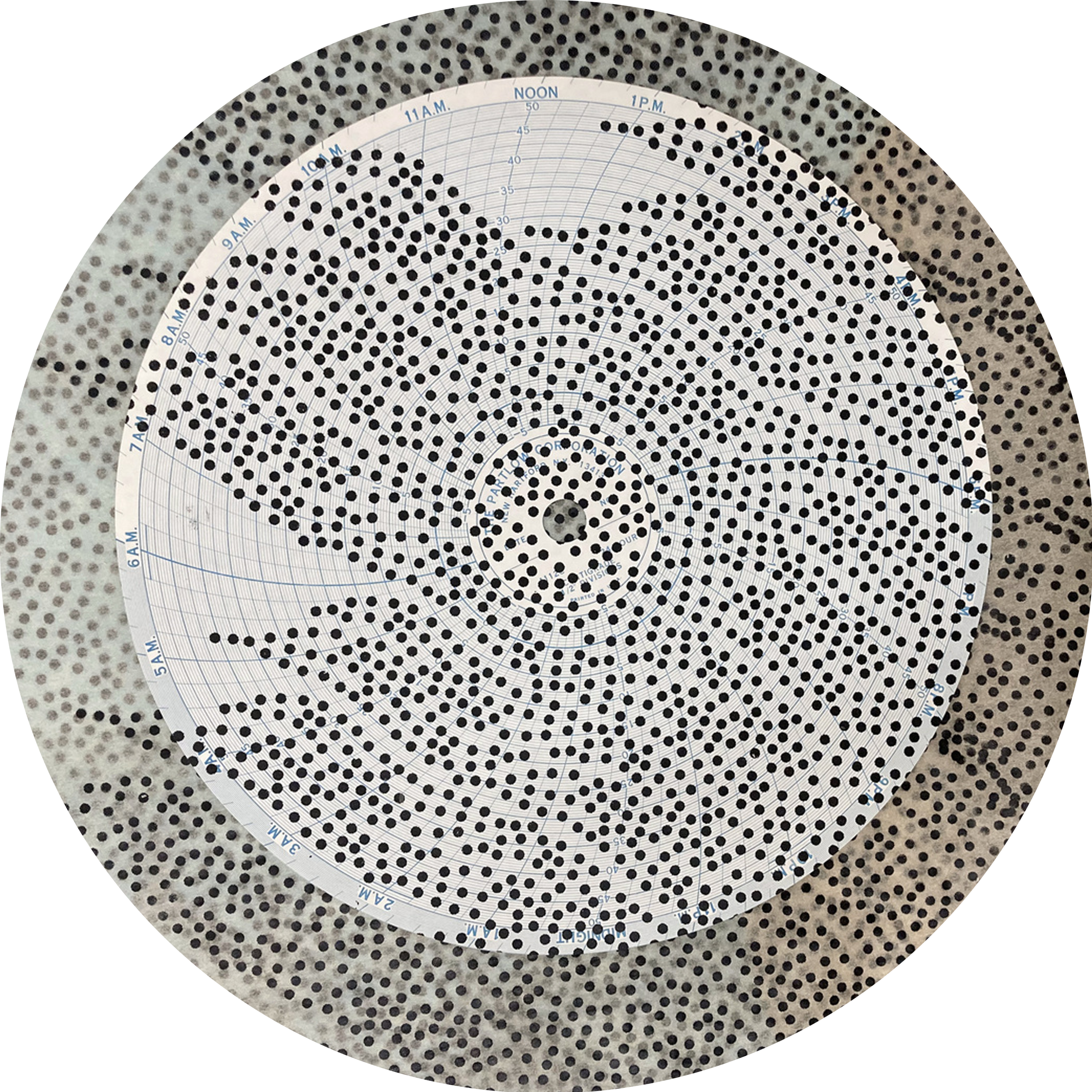
Third Coast Disrupted:
Artists + Scientists on Climate
An exhibition of commissioned artworks culminating a yearlong conversation between artists and scientists centered on climate change impacts and solutions in the Chicago region and beyond. Through science-inspired sculpture, painting, collage, video, and installation, the artworks explore current local impacts – ranging from extreme heat to flooding to habitat loss to pollutants. They also shine light on local solutions underway, like backyard habitat restoration and nature-based approaches to slowing stormwater. The works weave together a story – from the intensely personal to the observational. They relate the granular to the global.
ARTISTS: Jeremy Bolen | Barbara Cooper | Hector Duarte | Rosemary Holliday Hall | N.Masani Landfair | Meredith Leich | Andrew S. Yang
SCIENTISTS: Elena Grossman, MPH | Daniel Horton, Ph.D. | Abigail Derby L ewis, Ph.D. | Aaron Packman, Ph.D. | Katherine Moore Powell, Ph.D. | Desi Robertson-Thompson, Ph.D. | Philip Willink, Ph.D.
CURATORIAL TEAM: Christine Esposito, Founder, Terracom: Director and Lead Curator | Liam Heneghan, Professor, Environmental Science and Studies, DePaul University: Science Curator | Lisa Roberts, Ph.D., Principal, naturalia inc: Art Curator | Meg Duguid, Executive Director, Dept. of Exhibitions, Performance and Student Spaces, Columbia College Chicago: Senior Consultant
Take a virtual tour and learn more on
www.thirdcoastdisrupted.org
JEREMY BOLEN | Albedo

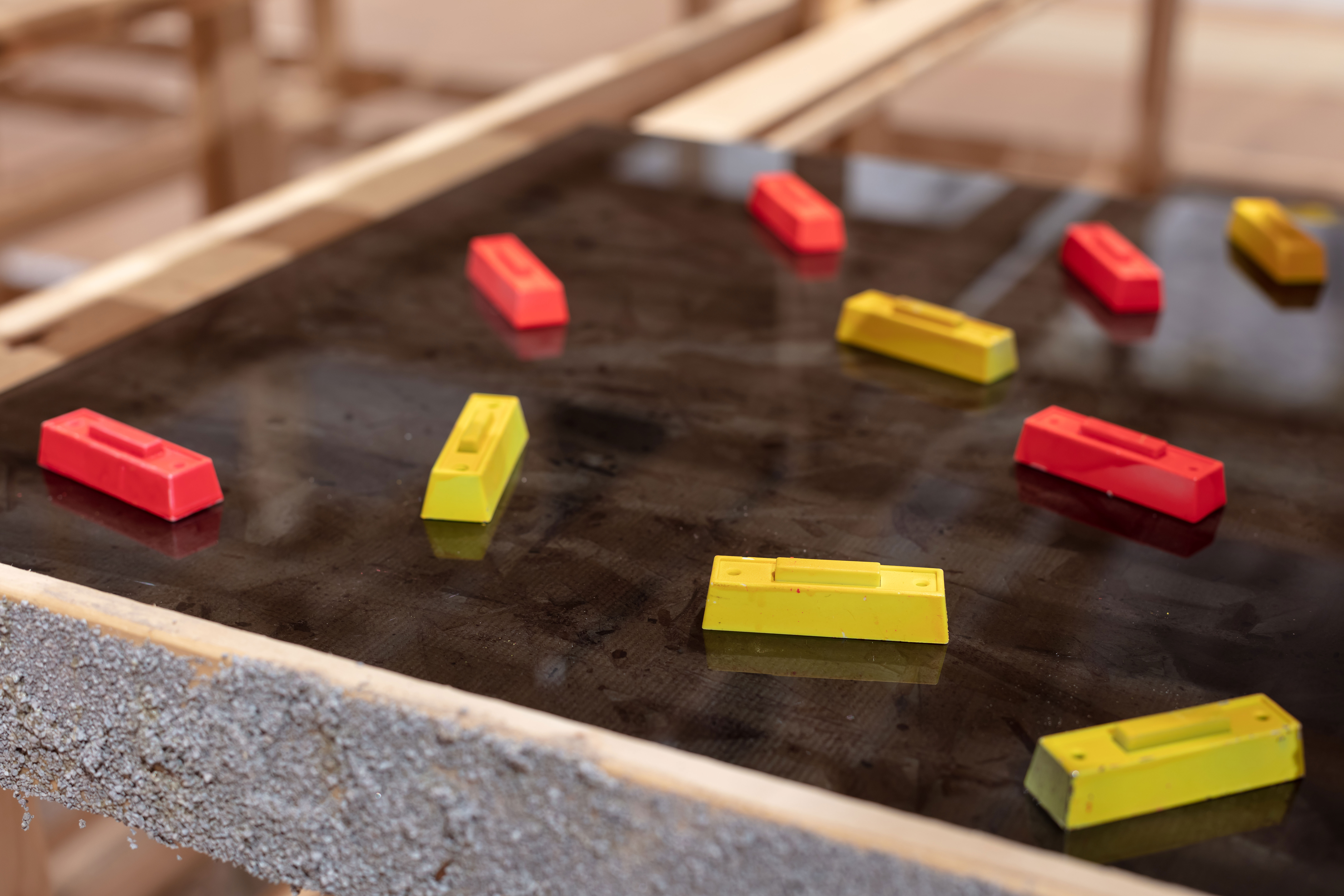




wood, white roofing granules, modified humidifier carbon capture units, door bells,
carboncure concrete, tinted plexiglass, radiant barrier insulation, sorbent,
soil from the city of Chicago, grass seed, artificial grass
BARBARA COOPER | Seep
![]()
![]()
![]()
![]()
![]()
![]() screening, abaca paper pulp, salvaged plastic water bottles, beeswax
screening, abaca paper pulp, salvaged plastic water bottles, beeswax
This work formed around a question: Can the earth, the atmosphere, and the multitude of earth-bound organisms “digest” what humans generate from an increasingly toxic industrial complex? -Barbara Cooper
With plastic embedded throughout the organic forms of Seep, the sculptures examine the ubiquity of plastic in Earth’s ecosystems, our life-support systems, even our bodies.
Cooper made the forms by manipulating screening and found plastic water bottles, mirroring how plastics in daily life become implanted into the organic world. The sculptures reference the body systems that absorb food, water, and air, all of which harbor microplastics. The work draws attention to Earth’s inability to process these and other human interventions – making the environment less resilient to the impacts of climate change.
Water, microplastics, and climate change commentary by Katherine Moore Powell, Ph.D. Ecohydrologist and Associate at The Field Museum
carboncure concrete, tinted plexiglass, radiant barrier insulation, sorbent,
soil from the city of Chicago, grass seed, artificial grass
Photos: Eileen Ryan & Jonathan Castillo
During Chicagos deadly heat wave of 1995, more than 700 people perished over a five-day period that saw triple-digit temperatures. Many were poor, elderly residents of color sequestered without air conditioning behind locked doors. The bodies of 41 victims were never claimed. Albedo acts as a generative memorial that memorializes them.
The installation demarcates the 41 coffins of the unclaimed victims who were buried in an unmarked grave at a near suburb of Chicago. The wooden structures are coated with white roofing granules transforming caskets into a heat and light reflecting cabinet of both mitigation measures and speculative possibilities for reducing the severity of and adapting to our changing climate. Included in the installation are carbon capture units that were recently innovated at Oak Ridge National Laboratory, using hacked humidifiers to absorb carbon from the atmosphere. To complete this speculative system Bolen created concrete replicas using CarbonCure concrete, a material which embeds captured carbon permanently.
Public health & climate change commentary by Elena Grossman, MPH, Public Health professional at University of Illinois Chicago School of Public Health
The installation demarcates the 41 coffins of the unclaimed victims who were buried in an unmarked grave at a near suburb of Chicago. The wooden structures are coated with white roofing granules transforming caskets into a heat and light reflecting cabinet of both mitigation measures and speculative possibilities for reducing the severity of and adapting to our changing climate. Included in the installation are carbon capture units that were recently innovated at Oak Ridge National Laboratory, using hacked humidifiers to absorb carbon from the atmosphere. To complete this speculative system Bolen created concrete replicas using CarbonCure concrete, a material which embeds captured carbon permanently.
BARBARA COOPER | Seep




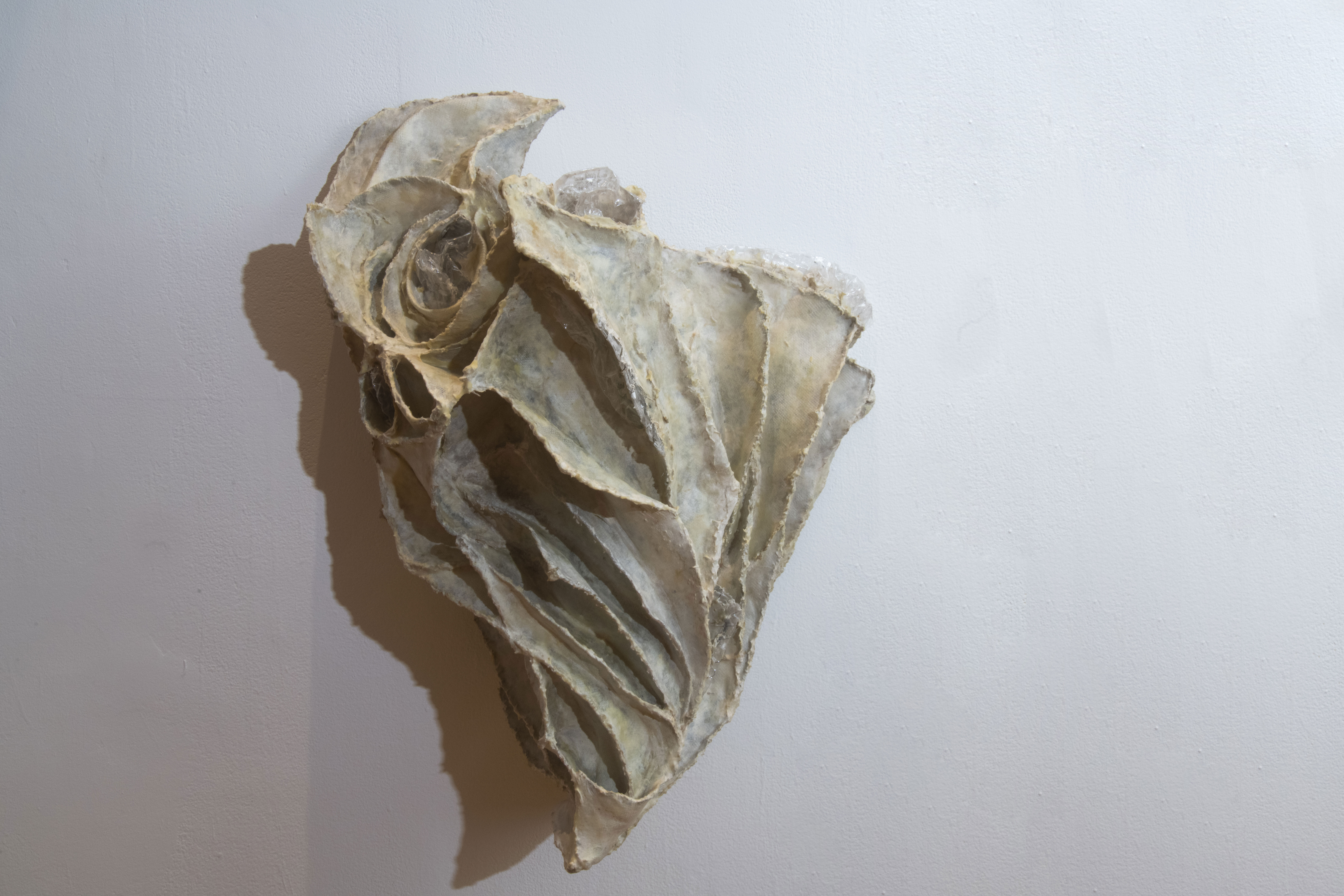

This work formed around a question: Can the earth, the atmosphere, and the multitude of earth-bound organisms “digest” what humans generate from an increasingly toxic industrial complex? -Barbara Cooper
With plastic embedded throughout the organic forms of Seep, the sculptures examine the ubiquity of plastic in Earth’s ecosystems, our life-support systems, even our bodies.
Cooper made the forms by manipulating screening and found plastic water bottles, mirroring how plastics in daily life become implanted into the organic world. The sculptures reference the body systems that absorb food, water, and air, all of which harbor microplastics. The work draws attention to Earth’s inability to process these and other human interventions – making the environment less resilient to the impacts of climate change.
HECTOR DUARTE | Requiem for Two Spirits, Defenders of the Migrant Tümü (Butterflies)
![]()
![]()


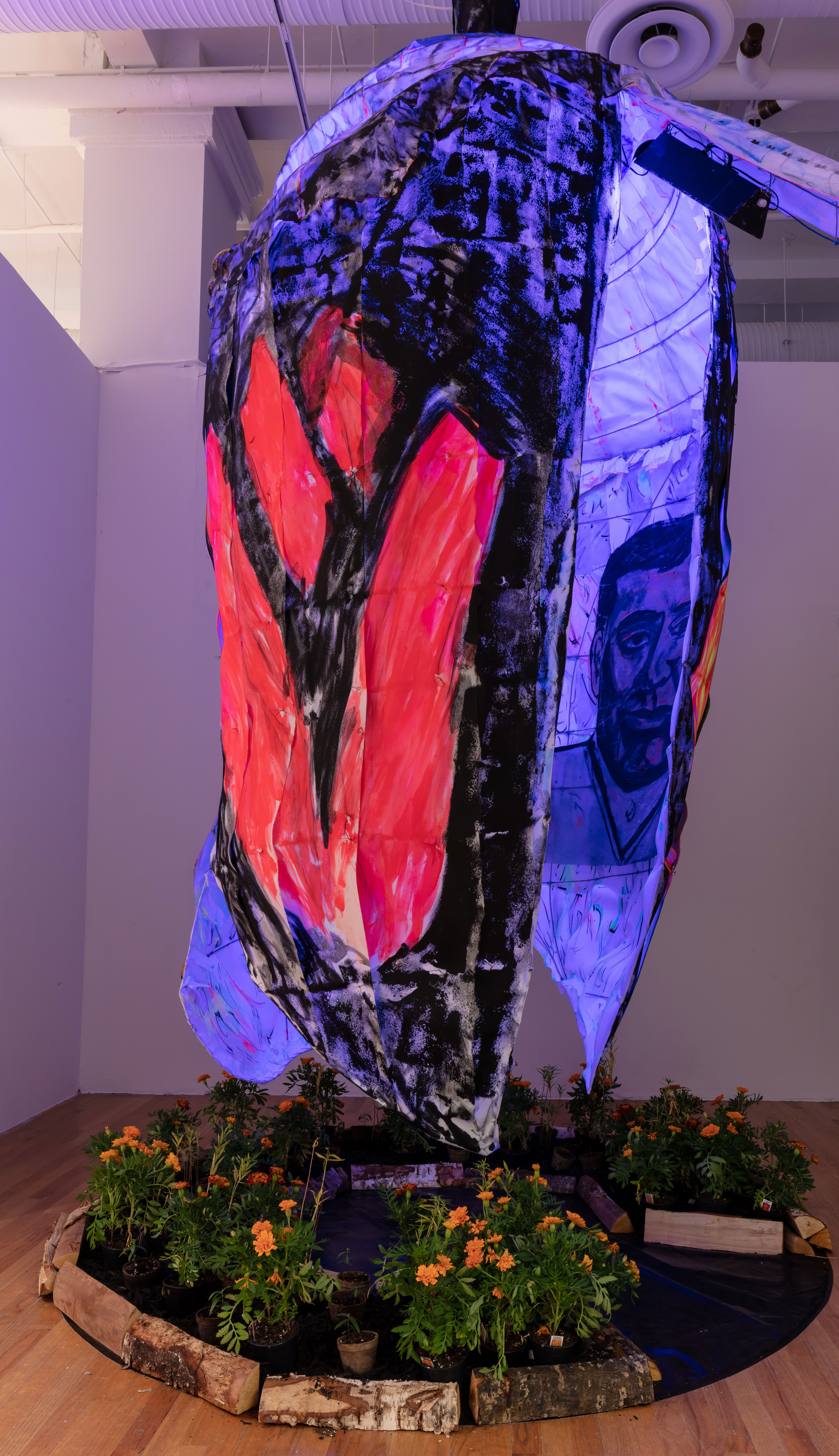

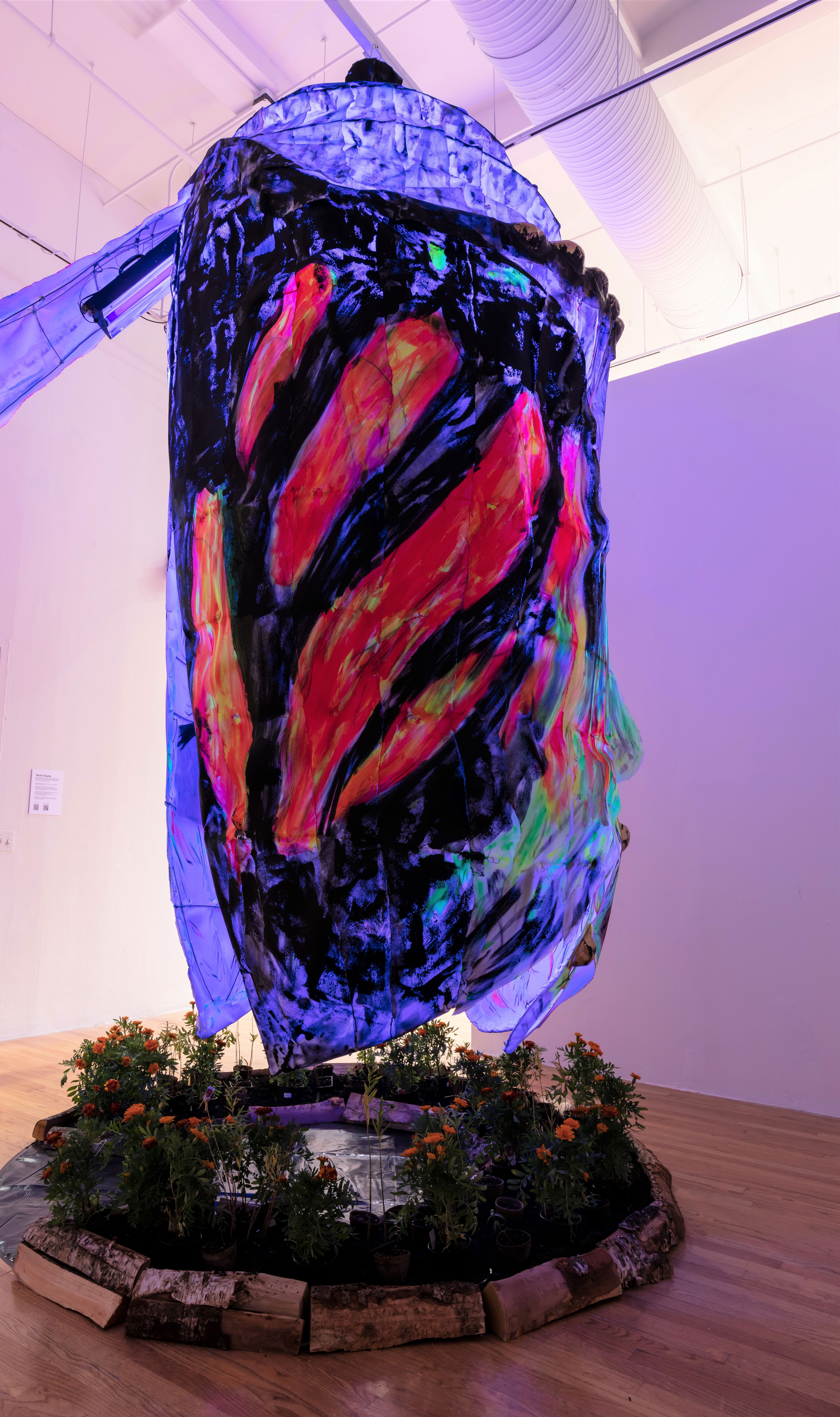
Monarch butterfly chrysalis out of wire, interfacing, cloth, and gauze, pastel drawings, paint, milkweed and marigolds plants
I have used butterflies in my artwork as a symbol for human migration from Latin American. And that’s how I began to understand the danger to butterfly habitats both in the US and in Mexico. In Michoacán, many people believe that the souls of their departed loved ones return with the butterflies, since they arrive around November 2, the Day of the Dead. This installation is in honor of two people who gave their lives to defend the habitat of the monarch butterfly there in the State of Mexico. - Hector DuarteWith acrylic and pastels, Duarte painted the faces monarch butterfly conservationist and activist Homero Gómez González, 50, and Raúl Hernández Romero who were murdered protecting monarch butterfly habitat in Michoacán, Mexico in 2020. Duarte wanted to honor them and their courage and shed light on dwindling monarch populations, a problem worsened by climate change. Marigolds at the base of the work reference the Mexican Day of the Dead, which coincides with the return of monarchs to Michoacán. The streamers and soaring spiral cascades from their portraits suggesting the ascension of the men’s spirits and a portal to the next dimension.
Monarch butterflies, habitat loss, climate change, and the role cities can play to provide habitat for monarchs by Abigail Derby Lewis, Ph.D. Senior Conservation Ecologist at the Field Museum
N. MASANI LANDFAIR | Breathing to the Next Breath
![]()
![]()
![]()
![]()




found objects, wood board, photographs, medical tape, posters, mold, vinyl
This work centers on my family’s experience with flooding, mold infestation, and the subsequent
physical and mental health issues that were caused by climate change.
Home should bring thoughts of safety, security, and sanctuary, but this is not the case for a majority of Black, Brown, and Indigenous people that deal not only with environmental toxins from local plants and industry, but also the subtle effects of climate change.
These found object and collage works form from abstracted memory and present health issues I deal with from that experience. I hope to convey the deep feelings of loss, growth, healing, and understanding of how our actions to our local and ultimately world environment only come back and affect us. - N. Masani Landfair
Landfair explores the mental and physical tolls of living in a chronically flooded home on Chicago's South Side. Climate change’s more intense storms and floods hit low-income communities and communities of color hardest. The work consists of three found-object collages on found, water-damaged wooden boards. Imagery of mold surrounds them. Regular markings on the background between the boards and beyond suggest the rhythm of breathing. The first panel uses photos of the artist's flooded basement, cut up and reassembled into a convoluted form that references the unseen growth of black mold in the walls of the artist’s home. The middle panel relates the artist’s efforts to reorganize her life and heal after prolonged mold exposure. The red line references lifeline, blood, living, breathing. Medical tape and the backs of torn-up, water-damaged posters create the white, clinical effect. Images of mold and actual mold spores (sealed in gel) reflect the insidious threat. On the final panel, a photo of the artist’s underwater basement floor reflecting a sunlit basement window is a meditation on acceptance.
ROSEMARY HOLLIDAY HALL | River of Shadows, Liquidation
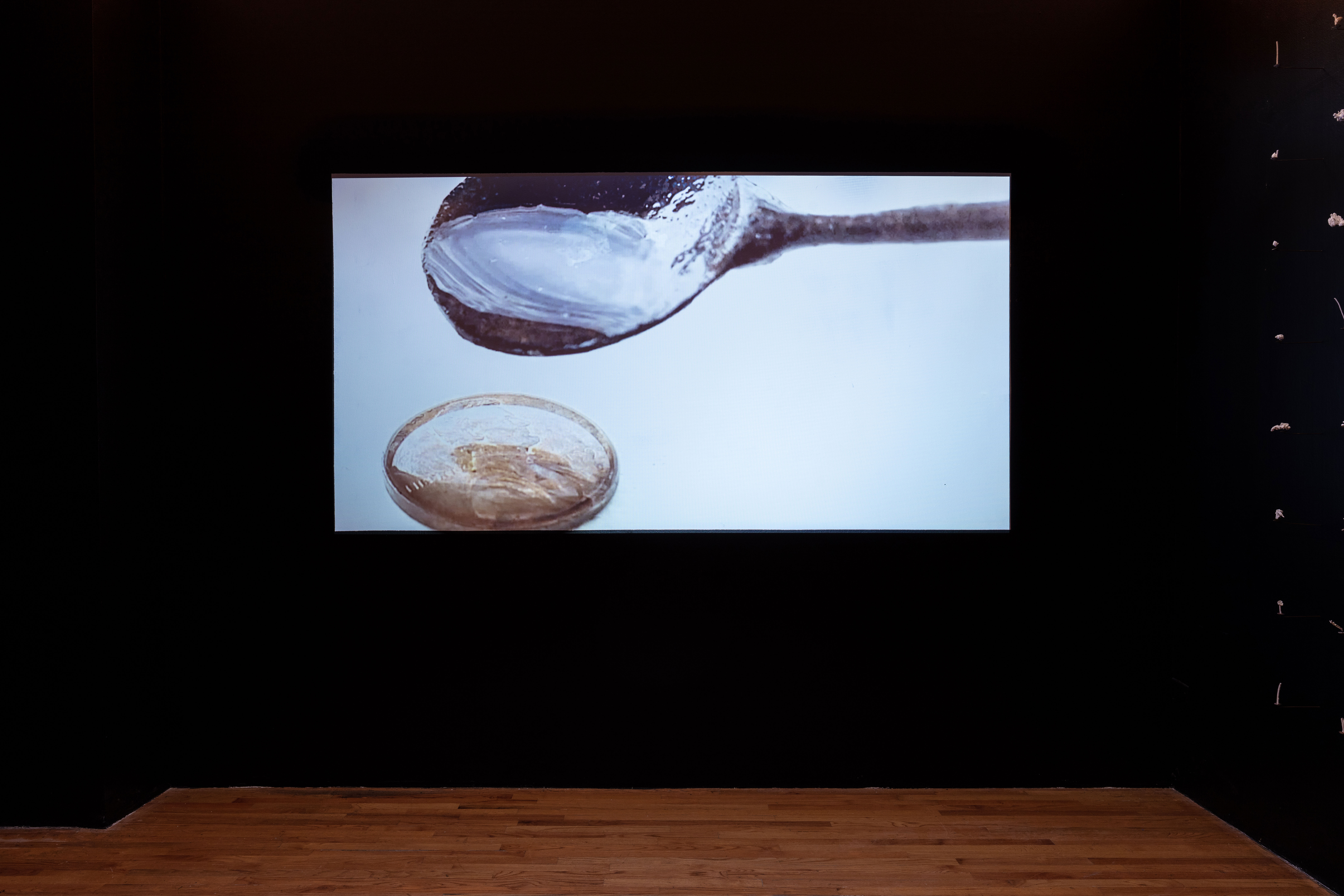



Hall’s multimedia installation explores economies and ecologies of water as a subject of tension. As temperatures rise the atmosphere can physically hold more water, which is made visible through extreme weather events, flooding, and drought throughout the planet.
In a dark room the viewer is enveloped in the folk song “Goin’ Down the Road Feelin Bad.” Projected on one wall is a spoon pouring water onto a larger-than-life penny that slowly reaches capacity. The video suggests value systems based in economies of extraction have driven the road we are on to a bad place, a catastrophic tipping point. Accompanying the video is an installation of 108 ceramic casts of water retaining plants and seeds, which ask- how might we plant seeds for a living, lively, and more resilient future? Like ghosts of the present, the plants suggest the future of our planet lies in systems of value beyond monetary systems and towards those that value care and an understanding of the inter-being of all organisms on this planet.
MEREDITH LEICH | Chicago and the Rain
![]()


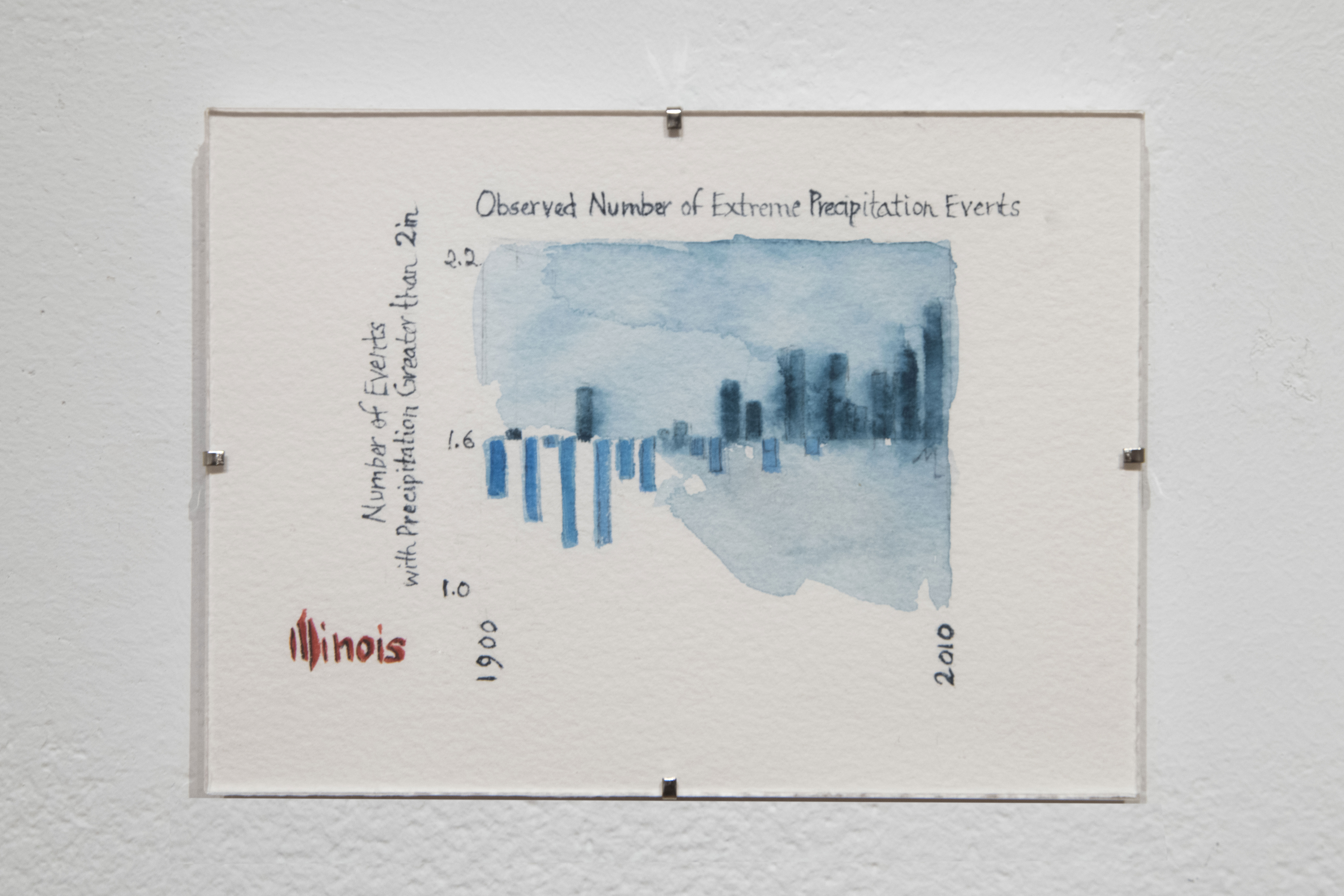
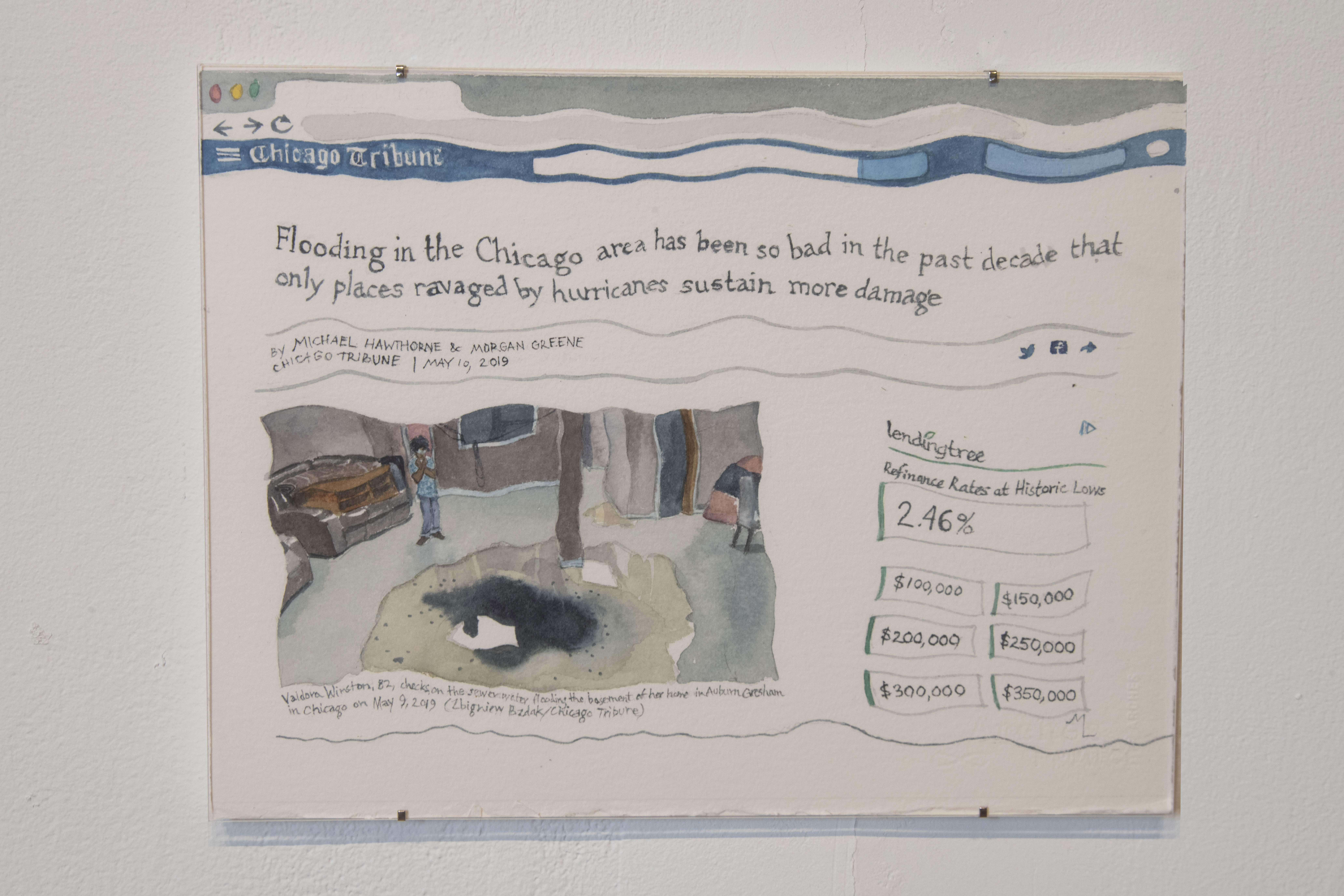


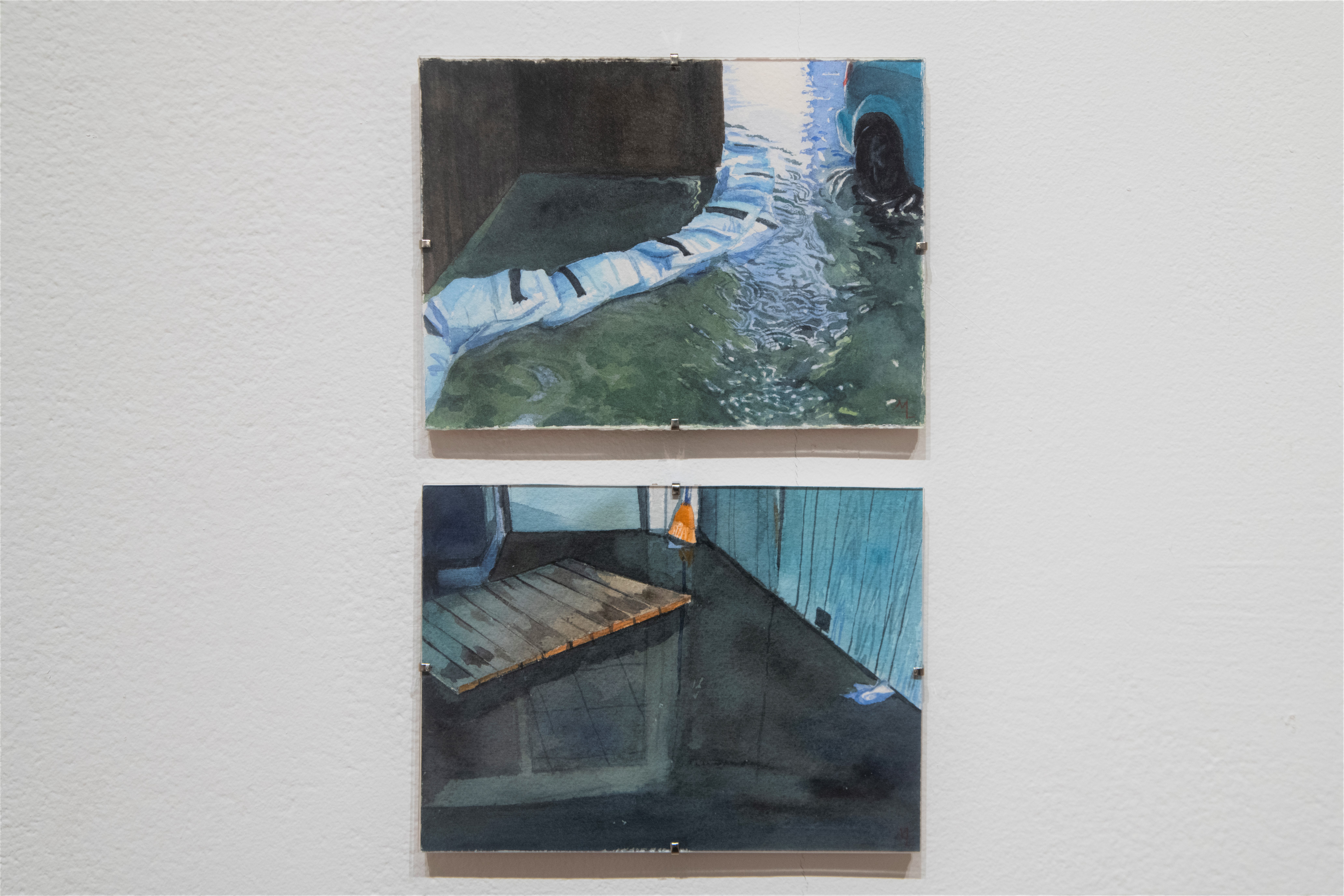
“There’s no denying that the stormwater-management infrastructure built in the 1920s, 1950s, and 1970s has been overtaken by the swiftness and violence of climate change, and that the current infrastructure has not solved all the flooding problems that Chicago and Cook County face.” - Debora Shore, Former Commissioner, Metropolitan Water Reclamation District of Greater Chicago, June 2020. The Chicago region’s changing climate has brought more frequent intense downpours, causing more flooded streets and basements, more property damage, more loss.
Through imagery of headlines, scientific data, and fantastical scenes, Leich’s watercolors and animation assembles a story of increasing water, documenting damage already unfolding. It also imagines a range of possibilities, including a return to Chicago’s absorptive native prairies for a more porous city.
The fulture of flooding, urban hardscapes, and climate change by Philip Willink, Ph.D. Aquatic Scientist
Through imagery of headlines, scientific data, and fantastical scenes, Leich’s watercolors and animation assembles a story of increasing water, documenting damage already unfolding. It also imagines a range of possibilities, including a return to Chicago’s absorptive native prairies for a more porous city.
ANDREW S. YANG | Parts-per-Million (planetary aspirations)
![]()
![]()





Parts-per-million (planetary aspirations) is about the air we breathe every moment. We exhale carbon dioxide naturally from our bodies, but also pump it out by the gigaton from our cars, factories, and power plants the world over. Through the physiological aspirations of our breathing we connect directly to the planet’s carbon cycle; at the same time, through the economic aspirations of our fossil-fueled culture, we radically alter the composition of the air, those gigatons of carbon dioxide contributing to a global warming that radically threatens the stability of the climate we all rely upon. – Andrew S. Yang
In the 200 years since the Industrial Revolution, we have increased the amount of carbon dioxide in our atmosphere from 280 parts per one million air molecules to 415 parts per million. This deceptively small change is radically altering our planet’s climate – impacting our health and safety, and endangering myriad species the world over. Parts-per-million (planetary aspirations) uses one million dots to visualize this invisible threat. An aspiration is defined as both a hope and a breath. This work balances the causes and effects of rising carbon dioxide through the use of the word’s double meaning – human aspirations driven by fossil-fueled industrialization and the breath of all of Earth’s organisms.
Carbon dioxide concentrations, climate change, and collective action by Daniel Horton Ph.D., Climate Scientist Earth and Planetary Sciences at Northwestern UniversityIn the 200 years since the Industrial Revolution, we have increased the amount of carbon dioxide in our atmosphere from 280 parts per one million air molecules to 415 parts per million. This deceptively small change is radically altering our planet’s climate – impacting our health and safety, and endangering myriad species the world over. Parts-per-million (planetary aspirations) uses one million dots to visualize this invisible threat. An aspiration is defined as both a hope and a breath. This work balances the causes and effects of rising carbon dioxide through the use of the word’s double meaning – human aspirations driven by fossil-fueled industrialization and the breath of all of Earth’s organisms.
All Photos: Jonathan Castillo, Eileen Ryan, and Katy Osborn
Third Coast Disrupted was created through a collaboration between Columbia College Chicago, DePaul University's Institute for Nature and Culture, and Terracom.
It was partly supported by a grant from the Illinois Arts Council Agency and the Illinois Science & Energy Innovation Foundation, with additional support from Keith Giles and Christine Skolnik; Openlands; The Nature Conservancy; Clare Butterfield and Edward Maldonado; Patrick and Laura Clark; Debra Shore; Greenleaf Advisors, LLC; The Fogelson Family Foundation; and the Keller Science Action Center, Field Museum.